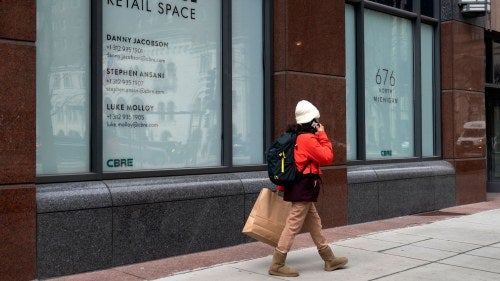Chicago's retail vacancies are hitting all-time highs. What can it learn from other global cities?

Reflecting a global trend, Chicago Loop retail vacancies hit a record 30%—most likely due to remote work—necessitating revival strategies.
The Chicago Loop last year hit its highest retail vacancy rate on record – topping 30% for the first time. The figure, announced last month, has more than doubled since 2019, when it rested at 14.92%.
Increased retail vacancies were common across the world during the COVID-19 pandemic, and Chicago is far from the only city that's struggled to rebound. According to a report from the McKinsey Global Institute, from 2019 to 2022, retail vacancy rates in major global urban centers increased by an average of 3.3 percentage points. However, Chicago does stand in striking contrast to some global cities whose dense and liveable urban cores have sustained a strong retail sector even in the wake of the pandemic. In Australia, for instance, Sydney and Melbourne both have retail vacancy rates in the single digits.
The highest retail vacancy rate on record. It's more than doubled since 2019, when it rested at 14.92%.
According to John Goodman, a Chicago-based vice chairman of the commercial real estate brokerage Savills, retail vacancies in a city's central business district (CBD) are highly correlated with its office vacancies. Office vacancy rates (which retail vacancies often lag behind) are at or near record highs not just in Chicago, but in Toronto, London, and other global cities, as well. Since in-office work has fallen since the pandemic amid a push to allow hybrid and work-from-home flexibility, retailers are less interested in renewing expensive leases in areas that now have considerably less foot traffic. This disinterest is also exacerbated by the shift in brick-and-mortar value assessments seen in the past decade as shopping has come to be increasingly done online.
“Historically, [office] vacancy rates have risen when companies have had to downsize as a result of reduced headcount,” Goodman told ChicagoGlobal. “In my 38 years — through three or four downswings in the office market — this is the first time where vacancy rates rose dramatically as a result of companies not reducing their headcount at all.”
While some global cities, like Tokyo, Paris, Seoul, and Singapore, saw their workers return to the office en masse as pandemic restrictions eased, Chicago — like most American cities — still has a fairly low rate of in-person work. Chicago’s average weekly office occupancy is higher than the national average and the average rates in New York City and Los Angeles, but it sits at just 56% of pre-pandemic levels. This makes sense in a city where 40% of jobs can be performed remotely, but it also means there are simply fewer people going into the CBD each day and patronizing its shops.
“Retail is very different than other [real estate] product types — office, industrial, medical — in that it is so heavily reliant upon footfall,” Todd Siegel, a Chicago-based senior vice president of the commercial real estate services and investment firm CBRE, told ChicagoGlobal.
"Successful retailing is really accessibility to the consumer."
For Siegel, the concern for Chicago’s CBD retail market is that the city’s businesses are facing the contraction of what was once a seven-day transaction period (that is, the time in which foot traffic for retail is high) down to a three-day transaction period, with the normalization of Tuesday-Wednesday-Thursday in-office standards.
“Not only have we done that,” Siegel added, “but that workforce likely isn't staying around for dinnertime. And so those retailers that are now transacting three days a week are really only transacting breakfast and lunch. So, we've shrunk in the week, and we've shrunk in the hours that they are transacting.”
This is different in a city like Sydney, for example. As of the second half of last year, the Australian city’s vacancy rate in its central business district was just 8.1%, according to a report from CBRE. That is partially due to higher return-to-office rates (Australia hit 71% of 2019 levels in 2023), but it’s also due to Sydney’s CBD layout.
“The physical real estate of residential, of office, of tourism, of theater, of culture is much more dense and much more prolific in Sydney’s CBD than Chicago’s CBD,” said Siegel.
Another report from the McKinsey Global Institute made a similar comparison between American cities and their overseas counterparts: “In general, U.S. urban cores were more affected [by hybrid-work policies] than European and Japanese ones, which tend to have more mixed-use development, in which office, residential, and retail space exist alongside one another. […] Cities with office-dense real estate and little mixed-use development, as well as expensive housing and little green space, have tended to experience a greater impact on demand.”
While the Loop is host to a number of attractions (like Millennium Park, the theater district, and the Willis Tower, which draws 1.7 million visitors annually), Sydney’s CBD has a livelier bar and culture scene and is more physically compact, leading to higher footfall. Similarly, the McKinsey report notes Paris, too, “has a great deal of mixed-use development.”
Furthermore, explained Siegel, the physical space of stores is smaller in most global cities, where retailers operate within smaller, cheaper, and more attractive storefront properties that are more fit-for-purpose in the era of online shopping than the massive department stores that operate in much of Chicago’s center, including and especially on North Michigan Avenue.
Still, while vacancy figures in Chicago may look scary, according to Goodman they are a medium-term concern as the market corrects. Investment in the Loop will return eventually, he believes, because leasing prices for offices and retail shops will come down to meet the lowered demand. Sale prices in the Loop have already come down 50%, making downtown real estate a more attractive investment, especially since the Loop is still highly accessible by all major modes of mass transit.
“85% of the market just wants well-located space where their people can get to it,” he said.
"Corporations, law firms, investment banks want to be in downtown Chicago for access to young talent… That's the most important criteria for companies deciding where they want to locate."
In addition to a natural return of demand for Chicago’s central business district, the city is also considering policy options to kickstart growth, such as tax increment financing. Mayor Brandon Johnson is currently working with developers to revamp empty buildings along LaSalle Street for an estimated cost of $1 billion. Meanwhile, Google is set to move into an updated Thompson Center by roughly 2026, and JPMorgan last month recommitted to their office space in Chase Tower.
Still, if Chicago wants to revitalize its CBD, perhaps taking inspiration from the likes of Sydney and Paris by incorporating more mixed-use development and non-office leisure activities into the downtown center would help incentivize a faster return of retail.
“As a civic body, we need to figure out a way to extend the hours of shopping, extend the workday, extend the workweek,” said Siegel.
“Can we take large areas of space that do exist in the Loop and can we figure out a way to create a public space where consumers aren’t just coming to the CBD to complete work, but where they’re coming as a place of leisure?”
This story first appeared in the ChicagoGlobal newsletter, a joint project of Crain's Chicago Business and the Chicago Council on Global Affairs.

